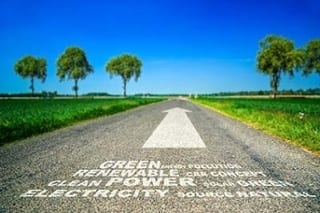Eco-Friendly Paint Helps you Make a Positive Impact on the Environment
(And Helps Your Company Save Money)
Facilities and maintenance managers are commonly tasked with reducing costs while using eco-friendly products. Managers at parks, universities, and corporate facilities are often measured by an environmental scorecard with one of the key metrics being procurement of bio-based products. Initially, this may feel like being stuck between a rock and a hard place, as eco-friendly and bio-based products are not necessarily known as economical or superior performers. However, an increased demand for these products has resulted in an influx of bio-based alternatives to traditional products that offer greater environmental impact ratings and perform well enough to result in decreased product life cycle costs compared with traditional products.
One proven product that checks these boxes is bio-based paint for parking lots and walkways, three major benefits of which are discussed below:
1. Longer Lasting
Striping paints that are ecologically-safe and soybean-based are designed to outlast petroleum-based paints. The paint also dries harder and features also dirt-repellent characteristics, allowing it to maintain a like-new look for a longer period than traditional acrylic and oil-based paints. As a result, the striping lasts longer and requires less frequent repainting, a long-term cost saving opportunity. Importantly, the paint can be applied with the same equipment used for traditional paints, so no additional investment in equipment is required to take advantage of the product’s superior performance and environmental attributes.
2. Environmental Performance
Environmental performance is a key metric on which facility managers are graded at sustainability-minded organizations. Bio-based paint utilizing natural soybean oil in its binder allows for low VOC (volatile organic compound) content, unlike petroleum-based alternatives. With bio-based paints, these toxic gases are no longer emitted during application and drying. High VOC levels are known to cause headaches and dizziness in the short-term and are damaging to the ozone and atmosphere.
3. Building a Sustainable Culture
Using low-VOC paints demonstrates an organization's commitment to sustainability. Organizations who are actively managing water waste, reducing energy and eliminating harmful chemical emissions also reap the benefits of improving their public perceptions. Company and university boardrooms have become fully aware that consumers have a heightened sensitivity to the environment and are rejecting organizations who do not help to preserve it. Organizations that strive to reduce their carbon footprint and maintain proactive sustainability programs are benefiting from this shift in the public’s psyche.
Many companies have been commercially rewarded for foresighted efforts to re-formulate harmful products. Others have lost significant chunks of business because of their staunch support for traditional products that are harmful to the environment. As consumers become more conscious of environmental impact and sustainability, organizations’ bottom lines will be more heavily impacted by their commitment to minimizing their environmental footprint in the communities in which they operate.
If you think your organization may be ready to trade petroleum for soybeans in your paint, give BioStripe® a call today!
What eco-friendly products does your organization use? Share examples in the comments below!
Are you looking to resurface your driveway with an eco-friendly product? Learn more about the safer way to rejuvenate & seal your driveway, BioSealSafe™.


